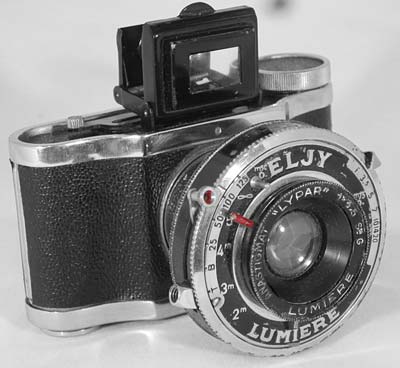Lumière Super Eljy (Type 3)
Specification

| Manufacturer | : | Lumière |
|---|---|---|
| Produced | : | 1940 |
| Classification | : | Miniature |
| Body Type | : | Extending Body |
| Construction | : | Metal |
| Film type | : | 30mm Rollfilm |
| Film Width | : | 29mm |
| Image Size | : | 35mm x 23mm |
| No. of Images | : | 8 |
| Lens Type | : | Lypar Anastigmat |
| Focal Length | : | 40mm |
| Focus Type | : | Variable |
| Focus Range | : | 0.5m to inf |
| Aperture Type | : | Variable Iris |
| Aperture | : | f/3.5 to f/20 |
| Shutter Type | : | Pivoted two-blade return |
| Shutter Speeds | : | T,B,I(1/25, 1/50, 1/100, 1/125 sec) |
| Size Open (w x h x d) | : | 78 x 64 x 57 mm |
| Size Closed (w x h x d) | : | 78 x 52 x 43 mm |
| Weight | : | 185g |
Art Deco Credentials
![]()
![]()
![]()
![]()
Significant: Pronounced and self evident
- Produced during the main Art Deco period;
- Art Deco lettering on face plate;
- Black & chrome face plate;
- Curvilinear design;
- Chrome embellishments to body;
- Chrome embellishments to tripod mount, film door lock and winder;
- Chrome extension tube.
Description
The Lumière Eljy was manufactured between 1937 and 1960. There was a significant excusion from the original design in 1951 when the Eljy Club was brought out. It was a modernised version of the Super Eljy with a superior lens and shutter, and was equipped with an extinction meter.
This version of the design is the Super Eljy (Type 3) and is a very hansome camera which is extremely well built. It is a small camera but the frame size is the same as a 35mm camera. The use of roll film allows it to dispense with the sprocket holes. Unfortunately, you only get 8 images on the film.
The lens board and shutter are attached to a chrome tube which is extended during use. The shutter provides speeds of T,B and instantaneous speeds ranging from 1/25s to 1/125s. The aperture is an iris type giving a range from f/3.5 to f/20. It has front lens focussing which can go from infinity down to just 0.5m. It has a flip up viewfinder on the top of the camera. This viewfinder can be adjusted to account for parallax issues when close-ups are being taken. It has a red window with cover for advancing the film.
A tripod socket and a remote cable release socket are provided. The film door latch is marked with 'F'(Fermé - Closed) and 'O'(Ouverte - Open).
How to Use
The camera takes special 30mm film which is only available as expired film. Expired film normally needs to be overexposed by 1 stop/decade for colour film or 1 stop per 2 decades for B&W.
35mm film is too wide for the spools. You can cut down 120 film but you will probably have to develop the film yourself.
Looks like this is a 'shelf sitter' for the time being I'm afraid.